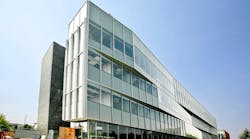The first part of a planned research complex, the new Pharmaceutical & Biomedical Sciences Building on Washington State University (WSU) Spokane’s Riverpoint Campus features research and teaching laboratories, classrooms, and administrative and faculty offices. Constructing the four-story, 125,000-gross-square-foot facility “was challenging, given the rigid temperature and humidity set points, 24/7 operation, and high ventilation rates that were required in a modern and architecturally pleasing building,” Ken Billington, construction administrator with Affiliated Engineers Inc. (AEI), who oversaw construction and worked with the contracting team to coordinate and complete installation of the mechanical, electrical, and plumbing systems, said.
“Spokane’s weather conditions, when combined with the sleek building facades, required a good amount of creativity to achieve sustainable operating costs,” Billington, who works out of AEI’s Seattle office, continued. “We feel that the end product resulted in a high-performance, state-of-the-art facility.”
Rapid Construction
“Work started at the biomed facility in the summer of 2012 and finished in November of 2013,” Gary Solberg, project supervisor and manager for Spokane-based mechanical-contracting and design-build specialist McClintock and Turk Inc., said. “It was a fast-track project, for sure.”
To keep pace, Solberg ran two shifts. For the majority of the project, McClintock and Turk kept 15 to 20 employees, including plumbers, pipe fitters, welders, and apprentices, on the job.
“One of our toughest challenges was packing all the mechanical components into limited ceiling space,” Solberg said. “The labs have high ceilings, further limiting the available space. Yet we needed to install two separate domestic-hot-water systems—one for the labs and one for restrooms—and complete systems for fire suppression, plumbing, hydronic heating and cooling, acid-waste piping for the labs, and sheet-metal ductwork.”
Design Challenges
Among the design challenges the building presented, two stand out in Billington’s mind:
- Conditioned-air delivery. The floor-to-ceiling glass curtain wall on the building’s north side—and resulting lack of space to run ductwork—made conditioning the perimeter difficult. Radiant panels—both floor- and wall-mounted—and a radiant heated/chilled slab help to condition perimeter spaces.
- Air balancing. With the potential for hazardous chemicals and materials in the air, pressure in laboratories needs to remain negative to prevent infiltration.
“Offset air tracking was incorporated into the building’s design,” Billington said. “This ensures proper pressurization independent of supply/exhaust-air quantities at any given time due to biosafety-cabinet and fume-hood operation in the laboratories. Pressurization remains constant during all operating phases of safety-cabinet and fume-hood operation.”
This was especially important at the building’s lowest level.
“An anatomy lab and other specialized lab spaces on this level were subject to even more stringent pressurization and air-change rates,” Billington said.
Equipment Selection
During the construction phase, McClintock and Turk worked with manufacturer representative Suntoya Corp., which supplied HydroTherm boilers, Taco pumps, expansion tanks, and accessories, and other key components.
There are two mechanical rooms in the building: one in the penthouse dedicated to heating and one in the basement dedicated to cooling. In the penthouse, six 3-million-Btuh condensing boilers are piped in series, assembled in a lead-lag-and-rotate configuration.
A fin-tube baseboard system provides supplemental heat to office spaces and meeting rooms. In stairwells, wall-mounted radiators are used. Spread across all floors of the building, 305 variable-air-volume boxes supply primary heat to some areas and supplemental heat to others.
Radiant ceiling panels and in-floor radiant tubing heat large zones, while the latter also provides cooling. A modulating three-way valve responds to outdoor and indoor conditions for ideal supply-water temperature and draws water from the boilers or chillers, depending on the need.
From the basement, three 275-ton Carrier Evergreen centrifugal chillers, with cooling towers on the roof, cool the building via the radiant system, with more than 300 chilled beams and coils serving the primary air-handling systems. The chilled beams, which are a mix of active and passive systems, are located throughout the office and laboratory areas. Radiant ceiling panels are utilized in public areas, including the cascading stairs on the building’s north face.
At full load, the building requires 18,000 MBH in heating mode and approximately 825 tons of cooling capacity.
Energy Recovery
In all, the heating and cooling systems contain approximately 6,000 gal. of water, a large quantity considering the facility’s size. Given copious amounts of insulation, that volume means valuable thermal mass, not standing heat loss. It also means a lot of pumping power.
The heating and cooling systems use 23 large vertical inline pumps from Taco. Each pump is outfitted with suction diffusers to conserve space in the mechanical rooms. Taco’s inline pumps feature a close-coupled design for improved alignment and increased seal life. Flow rates of up to 2,500 gpm and heads of up to 300 ft TDH are available for broad application.
“As is the case with most buildings of this type, and despite the number of pumps and the large water volume, the amount of energy required by utilizing pumped energy is substantially less than if fans and air-side equipment had been used exclusively to condition the building,” Billington said.
The building’s energy-recovery loop circulates fluid between two air streams and captures heat from the building’s exhaust, redirecting this energy to offset the heat required for building ventilation air. This results in a sensible effectiveness of up to 50 percent and equates to significant savings in overall heating cost.
Because of the potential for hazardous materials in the laboratories and the physical location of the two air streams being affected, an enthalpy-wheel energy-recovery system was not considered. High air exchange created the need for energy recovery. A runaround-loop system was chosen because it has been proven effective in transferring energy between process loads (exhaust-air heat) and required ventilation air while eliminating the potential for cross-contamination.
Dan Vastyan is an account manager for Common Ground, a trade-communications firm based in Manheim, Pa.
For Design Solutions author guidelines, call Scott Arnold, executive editor, at 216-931-9980, or write to him at [email protected].












